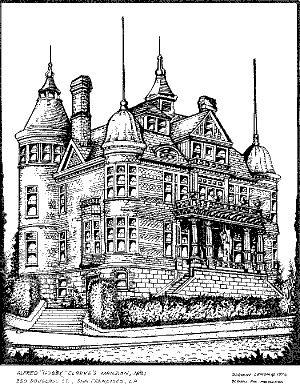
|
Alfred "Nobby" Clarke, Irish immigrant, sailor, goldminer, lawyer and policeman, was described in a 1902 edition of the San Francisco Examiner as a man almost as colorful at the famed Emperor Norton. While practicing law, he once had forty-five law suits pending, all of which were thrown out in a single day. He was jailed for contempt more than any other lawyer in United States history.
DELUSIONS OF GRANDEUR?
Late in his career his mind deteriorated. It was then, in 1891, that he announced, "I am going to build a great castle on seventeen acres at the foot of Twin Peaks." Mr. Clarke's castle was soon nicknamed "Nobby Clarke's Folly" because of its immense size and its remoteness from Nob Hill. In those days, the only dignified place for people of wealth to build mansions, was atop San Francisco's Nob Hill. Had he lived, however, Mr. Clarke would have had the last laugh. For the 1906 earthquake and fir destroyed nearly all of the mansions on Nob Hill while "Nobby Clarke's Folly" remained standing with only a few toppled chimneys.
Mr. Clarke sunk $100,000 into his project, which in those days was a sizeable fortune. However, he never recovered financially, and only enjoyed his elegant home for a few years. Due to financial reverses he was forced to spend his later years in a modest cottage on Masonic avenue.
IS THERE A DOCTOR IN THE HOUSE?
By 1904, the building had been converted into California General Hospital. An advertisement for the new hospital noted that elegant rooms were a dollar a day, it was the only building in the block, and was sheltered from the cold west wind. Many old-timers in the neighborhood were born in the mansion-turned-hospital.
About 1909 the mansion was tastefully converted into 15 apartments and most of the elegant decor was preserved. It is one of the most sought after buildings in The City in which to reside, with perspective residents often remaining on a waiting list for several years.
Comprised of 45 rooms on five floors, the mansion is one of the largest formerly private homes still standing in the State. It has 22 stained glass windows. (There are spaces for twice that number, but apparently funds ran short.), 10 fireplaces, 16 baths and 52 closets. The house stands on three city lots with the garden covering the fourth. Small statues and other artifacts have been unearthed in the neighboring grounds which once comprised the grand estate.
Although predominantly Queen Anne and Baroque, its style is eclectic (meaning a bit of everything). No two rooms are alike. Some are authentic San Francisco Victorian. Others are designed in the grand Continental manner with rococo and other elaborate ornamentation. The former music room has a Far Eastern flavor. On the fourth floor are Parisian-style garret apartments which were once the servants' quarters. Every room in the house either overlooks the dramatic San Francisco skyline or the garden abounding with flowers and birds.
FROM ABOMINATION TO ACCLAMATION
In the 20's Victorian architecture fell into disfavor. A 1928 publication comments, "Clarke built this house in the awful architecture of the nineties...It still stands in all its horrific architectural pretensions." Today, of course, Victorians are revered and treasured. Columnist Margo Patterson Doss refers to the mansion's "architectural splendors." The San Francisco Progress calls it "a stunning example of artistic workmanship." The Landmarks Preservation Advisory Board describes it as "imposing and impressive...and when viewed from the Northeast in particular it becomes an olio of architectural details and forms..." In 1975 it was selected by the prestigious organization, San Francisco Beautiful, to receive one of seven beautification awards and shortly after was officially designated an historical landmark by the Landmarks Commission.
SPIRITS AND POLTERGEISTS
On nights when the coastal fog creeps down over Twin Peaks and the nearby hills with long white fingers, the huge house looms darkly out of the weblike mist. The hollow "clops" of horses' hoofs on cobblestone streets and the rickety clink of carriages and harnesses can sometimes be heard passing by, unseen, on wet, cold streets outside the mansion. Although the mansion does not have a recognizable ghost in residence, some of the tenants have heard heavy measured footsteps in the hallways, passing by on their way to some ghostly business. Could these sounds be the ghost of Mr. Clarke returning to survey the old estate that he loved so well?
|

